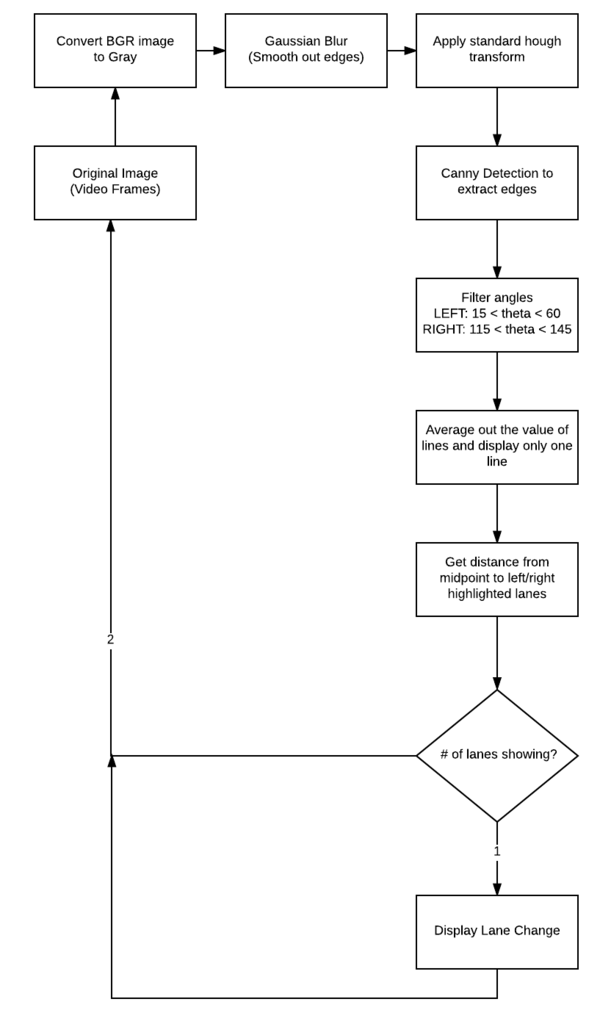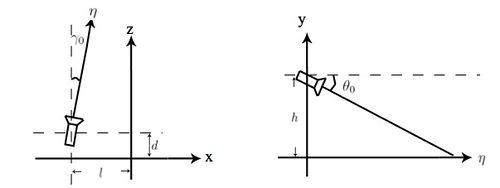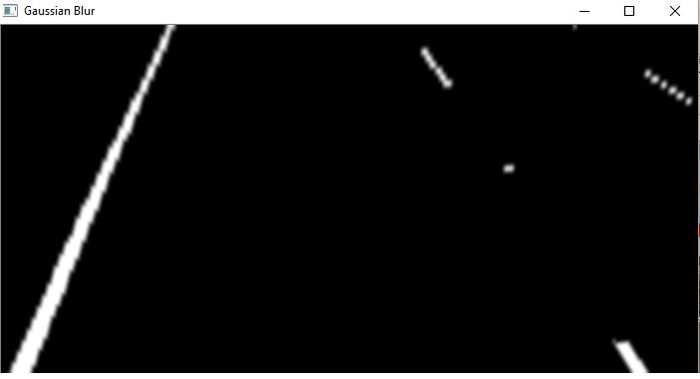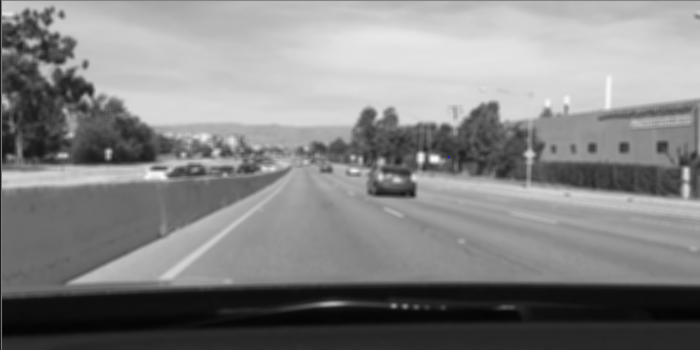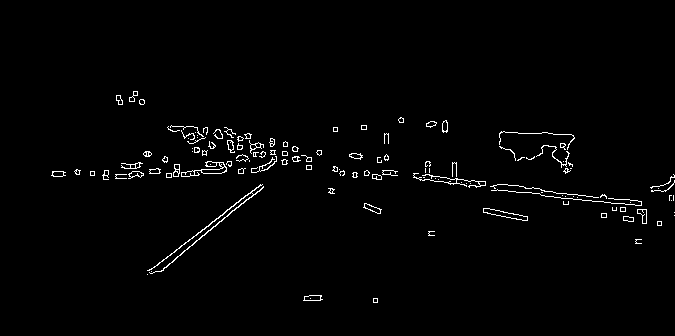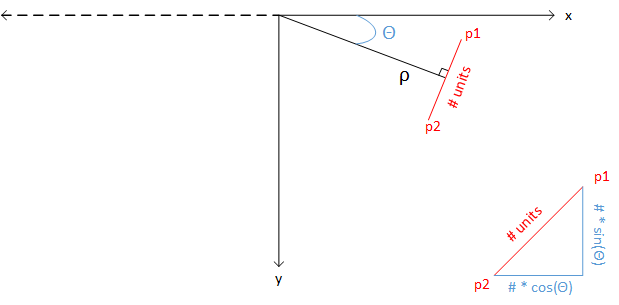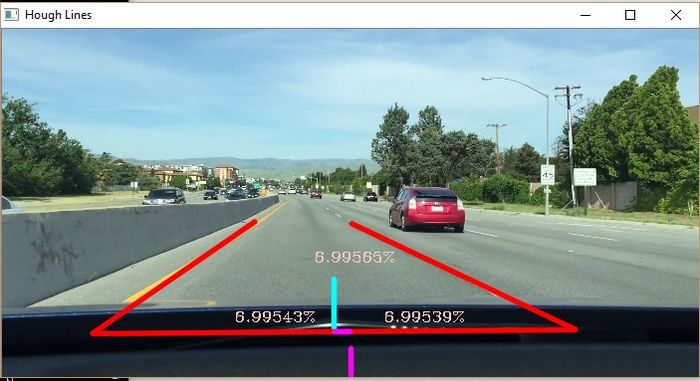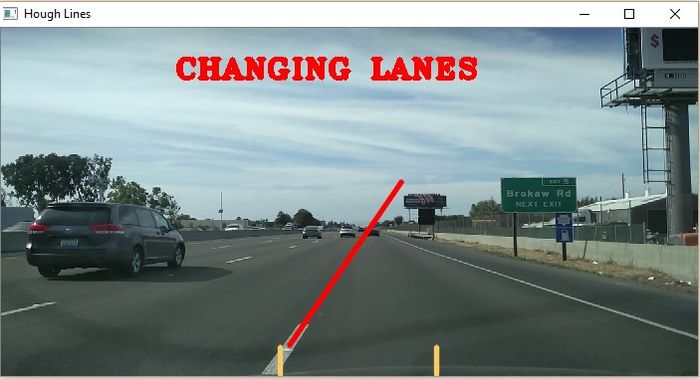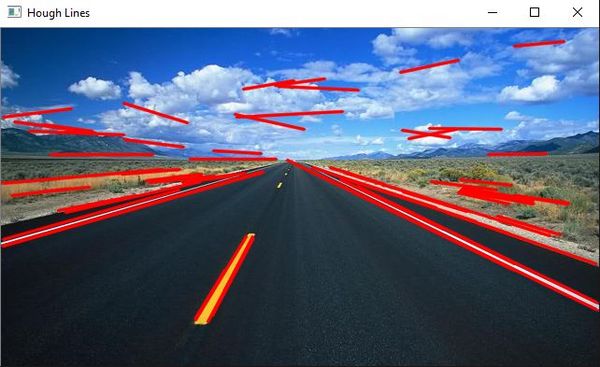Difference between revisions of "S16: Number 1"
Proj user17 (talk | contribs) (→Issue 2: Broken Lane Markings) |
Proj user17 (talk | contribs) (→Issue 2: Broken Lane Markings) |
||
| Line 263: | Line 263: | ||
Dotted lines are hard to deal with. Because Hough lines use a voting system, it's hard to find a proper a good point where it can detect dotted lanes without generating much noise. | Dotted lines are hard to deal with. Because Hough lines use a voting system, it's hard to find a proper a good point where it can detect dotted lanes without generating much noise. | ||
| − | A fix to this is to have an elapsed time where the lanes disappear. Because it takes time to change lanes, and the lines only disappear for a split second due to the speed of driving, we took made it so if the lines disappear for less than .3 seconds to continue on with the program. | + | A fix to this is to have an elapsed time where the lanes disappear. Because it takes time to change lanes, and the lines only disappear for a split second due to the speed of driving, we took made it so if the lines disappear for less than .3 seconds to continue on with the program. Only when the elapsed time is greater than .3 seconds do we deal with changing lanes. |
== Conclusion == | == Conclusion == | ||
Revision as of 07:55, 22 May 2016
Contents
Grading Criteria
- How well is Software & Hardware Design described?
- How well can this report be used to reproduce this project?
- Code Quality
- Overall Report Quality:
- Software Block Diagrams
- Hardware Block Diagrams
- Schematic Quality
- Quality of technical challenges and solutions adopted.
Project Title
Lane Warning System using OpenCV
Abstract
Drivers are in danger every day on the road. Changing lanes without notifying other drivers on the road will result in car accidents. Unsafe lane change is one of the top causes of car accidents on the freeway. In order to avoid car accidents by merging safely, drivers can 1) Always use the blinkers or turn signals. 2) Only change one lane at a time. 3) Never change lanes in an area where the lanes are separated by solid lines, only do so around dotted lines.
This system is built on top of OpenCV with computing capability on detecting the lane and provide a warning signal to the driver when they are about to be in danger. With the use of computer vision, the system will detect the current driver lane and provide a visual warning to the driver if no blinkers or turn signals is activated.
Objectives & Introduction
The goal of this project is to deliver a lane warning system using OpenCV. If the driver is about to make a lane change, the system will calculate the departed percentage and warn the driver if they are in danger.
OpenCV library and algorithm Overview
Color Spaces: This is a function to convert the original color to gray and HSV.
IPM (Inverse Perspective Mapping): IPM transforms the perspective of 3-D space into 2-D space.
Contours: Contours is to detect lane markings based on color and shape detection.
Gaussian Blur: Gaussian Blur is a diverse linear filter to smooth image on OpenCV. This is to smooth out edges and gets rid of unwanted noise.
Sobel Edge Detection: Sobel Edge ia an OpenCV to calculate the derivatives from the source.
Canny Edge Detection: Canny Edge detector is an OpenCV function to 1) Lower error rate 2) Better localization, and 3) Minimal response.
Hough Transform: The Hough Line Transform is a transform used to detect straight lines. This can be used after first edge detection processing.
Percentage offset: The percentage offset is used to determine how far away the center of the vehicle is from the center of the lane.
Team Members & Responsibilities
- YuYu Chen
- OpenCV Programmer
- Kenneth Chiu
- Programmer/Video supplier
- Thinh Lu
- OpenCV Programmer
- Phillip Tran
- OpenCV Programmer
Schedule
Show a simple table or figures that show your scheduled as planned before you started working on the project. Then in another table column, write down the actual schedule so that readers can see the planned vs. actual goals. The point of the schedule is for readers to assess how to pace themselves if they are doing a similar project.
| Week# | Date | Task | Status | Completion Date | Description |
|---|---|---|---|---|---|
| 1 | 3/21/2016 | Get individual Raspberry Pi 2 for prototyping & research OpenCV on microcontroller | Completed | 3/20/2016 | |
| 2 | 3/27/2016 | Continue Research and learning OpenCV. Familiarize ourselves with API. Know the terminologies. | Complete | 4/2/2016 | |
| 3 | 4/2/2016 | Complete various tutorials to get a better feel for OpenCV. Discuss various techniques to be used. | Complete | 4/2/2016 | |
| 4 | 4/4/2016 | Research on lane detection algorithms. IE. Hough Lines, Canny Edge Detection, etc. Start writing small elements of each algorithm. | Complete | 4/8/2016 | |
| 5 | 4/14/2016 | Run sample codes on a still, non-moving picture. | Complete | 4/8/2016 | |
| 6 | 4/20/2016 | Write our own algorithm, and test it. Camera input, Proper Hough Line generation. | Complete | Included blurring, edge detection, and Hough transform. This is the base for the lane detection.
Problem 1: A lot of noise being picked up by Hough transform. Status 1: Binarizing image seems to help decrease a lot of the noise. Gets rid of a lot of unnecessary objects Problem 2: Gaps in lanes do not complete Hough transform. Status 2: Currently working on Hough transform filters and Custom Region of Interest. Will possibly use birds-eye view. | |
| 7 | 4/22/2016 | Modify the code for our own project objective. Include a "lane collider" to see when we cross a lane. | Complete | ||
| 8 | 5/2/2016 | Implement the code with Raspberry Pi 2 | Complete | ||
| 9 | 5/8/2016 | Testing in Lab and attach feedback system | Complete | ||
| 10 | 5/14/2016 | Testing on the road | Incomplete |
Parts List & Cost
Raspberry Pi 2 - Given by Preet
Raspberry Pi camera - $20
Design & Implementation
The design section can go over your hardware and software design. Organize this section using sub-sections that go over your design and implementation.
Hardware Design
Discuss your hardware design here. Show detailed schematics, and the interface here.
Hardware Interface
In this section, you can describe how your hardware communicates, such as which BUSes used. You can discuss your driver implementation here, such that the Software Design section is isolated to talk about high level workings rather than inner working of your project.
Software Design
Below shows the basic algorithm on how lane detection can be achieved. The problem is that this will still produce a lot of noise, and intermediary steps must be done for proper lane detection.
The flow chart below shows how the entire program was done. From filtering out noise to lane switching.
Implementation
This section includes implementation, but again, not the details, just the high level. For example, you can list the steps it takes to communicate over a sensor, or the steps needed to write a page of memory onto SPI Flash. You can include sub-sections for each of your component implementation.
Color Spaces
gray & hsv
IPM (Inverse Perspective Mapping)
IPM can be thought of as a "bird's eye view" of the road. IPM transforms the perspective of 3-D space into 2-D space, therefore removing the perspective effect. Using this method is advantageous as it focuses directly on the lane marking instead of the surrounding environment. Therefore, reducing a lot of noise.
Mat findHomography(InputArray srcPoints, InputArray dstPoints, int method=0, double ransacReprojThreshold=3, OutputArray mask=noArray() ) // can be used to transform perspective from original to IPM
Although IPM was implemented and seemed promising, it was not used in the final version of the code. There was not enough time to further implement and transform/map the IPM coordinates back to the original video. Transforming IPM coordinates back to the original video can be done by:
cv::getPerspectiveTransform(InputArray src, InputArray dst) // to get the 3 x 3 matrix of a perspective transform cv::perspectiveTransform(inputVector, emptyOutputVector, yourTransformation) // to transform the your IPM points to original video points
Although implemented and experimented, it was not able to map broken lane markings.
The above image shows the bird-eye view of the road after applying filters.
Contours
Using contour to detect lane markings was based on color and shape detection. When a rectangular shape is detected and color is detected, a rectangular box is drawn around the contour as detection. Color detection, in this case would be yellow and white, for lane markings, can be found by adjusting the HSV filter threshold values. The main disadvantage of using color detection is that there may be false positives present.
Contours can be found using: void findContours(InputOutputArray image, OutputArrayOfArrays contours, OutputArray hierarchy, int mode, int method, Point offset=Point())
cv::Mat drawing = cv::Mat::zeros(gaussian_image.size(), CV_8UC3);
/* Draws a rectangle around the lanes */
for (unsigned int i = 0; i < boundRect.size(); i++) {
cv::rectangle(drawing, boundRect[i].tl(), boundRect[i].br(), cv::Scalar(0, 100, 255));
}
Lane detection using contour was experimented and the result was promising, but the algorithm implemented was expensive and also used IPM, which was not able to be mapped back to its original points. The decision was then to focus on reducing noise from hough transform because it did not use IPM and seemed more efficient.
Gaussian Blur
Gaussian Blur is used to blur out the image. is particularly useful to get rid of unwanted noise for the Canny edge. For example, clouds and trees all have numerous edges. By using Gaussian blur, we can make it seem like they don't have edges, so that Canny Edge detection won't detect the trees and clouds. Too much blur, and even the road's lines won't be traced out by the Canny Edge.
Canny Edge
Canny edge is used to trace out edges of the image. The lane markings have an edge, and will be traced by this function. This new image is will then be used to generate Hough lines.
Hough Line
This is where the lane marking extraction occurs. A standard Hough line transform is used to highlight lane markings. In the videos, the slanted, vertical red lines are generated by the Hough function. Hough uses a voting system where it analyzes the data of the images and gathers a certain amount of "votes". The needed amount of votes needed to be considered a line is done using the threshold value of the HoughLine function. This may require some trial and error to determine. Too small of a value, there will be a large amount of noise, too big of a value, the lanes may not be detected. Theta is the angle of the line relative to the x-axis, and rho is the length of the line. Since lanes are slanted vertically from the perspective of the driver, theta (in degrees) is filtered to be 15 < theta < 60 for the left lane and 115 < theta < 145. Using this filter, horizontal lines will never be displayed since they aren't necessary. Multiple hough lines will be generated in the lane, so an average was calculated so only one line per lane will be shown.
Rho will go to the mid point of the line. The line will be perpendicular to rho. p1 and p2 are then adjusted to be a a certain amount of units away from the the middle (rho), and p1 and p2 are on opposite ends. p1 and p2 are then fed into the cv::line() function, and a line is drawn.
Percentage offset
The percentage offset is used to determine how far away the center of the vehicle is from the center of the lane. The percentage offset is calculated when 2 lane markings are detected. It is calculated by using the distance formula (Pythagorean Theorem), using the closest points of the detected lane markings relative to the vehicle.
Three values are displayed:
The left value shows the percentage offset between the distances of left lane to center of lane boundary and to center of vehicle.
The center value shows the percentage offset between the distances from center of lane boundary and center of lane to to center of vehicle.
The right values shows the percentage offset between the distances of right lane to center of lane boundary and to center of vehicle.
Switching Lanes
The typical time for an average driver to switch lane takes about one to three seconds. Using this time parameter, we can tell if the driver is switching lanes. The definition of switching lanes is when the driver departs from one lane boundary into another. When departing one lane boundary into another, only one lane will be detected by the camera. When only one lane is detected and within the time parameter, it will check if the lane marking is within a given boundary for it to be considered switching lanes.
Another method implemented to detect switching lanes is to measure the distance between the lane marking to the center of the vehicle (camera). As the distance decrease between a certain distance threshold and time, it will be considered switching lanes. The distance is also calculated using the distance formula.
Testing & Technical Challenges
Describe the challenges of your project. What advise would you give yourself or someone else if your project can be started from scratch again? Make a smooth transition to testing section and described what it took to test your project.
Include sub-sections that list out a problem and solution, such as:
Issue 1: Noise
There are Large amounts of noise when generating Hough lines. This is because there are lines in each picture. Standard Hough lines do not work because you cannot set the minimum and maximum lengths of lines. Probabilistic Hough Lines are the best bet for this task. Even with Probabilistic Hough Lines, there is still quite a bit of noise.
Solution:
We did not use Probabalistic Hough Line. We used the standard one. Instead of using the Gaussian Blur, converting the image to HSV and then binarizing(threshold) it was sufficient. Adjusting HSV and threshold allows us to just the lanes. This is not perfect because there will still be some noise. To filter out more of the noise, we filtered out unnecessary horizontal angles because lanes from the driver point of view, is not horizontal, but slanted vertically. We filtered between the angles of 15 and 60 degrees for the left lane, and 115 and 145 degrees for the right lane. Erosion was also used to make the lanes appear thinner so we could get a better average.
Issue 2: Broken Lane Markings
Dotted lines are hard to deal with. Because Hough lines use a voting system, it's hard to find a proper a good point where it can detect dotted lanes without generating much noise.
A fix to this is to have an elapsed time where the lanes disappear. Because it takes time to change lanes, and the lines only disappear for a split second due to the speed of driving, we took made it so if the lines disappear for less than .3 seconds to continue on with the program. Only when the elapsed time is greater than .3 seconds do we deal with changing lanes.
Conclusion
Conclude your project here. You can recap your testing and problems. You should address the "so what" part here to indicate what you ultimately learnt from this project. How has this project increased your knowledge?
Project Video
Upload a video of your project and post the link here.
Project Source Code
References
Acknowledgement
Any acknowledgement that you may wish to provide can be included here.
References Used
List any references used in project.
Appendix
You can list the references you used.

